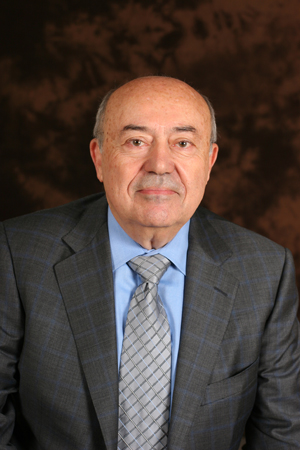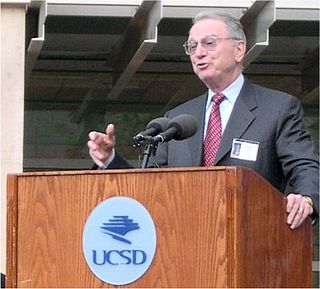Related Research Articles

Andrew James Viterbi is an Italian Jewish–American electrical engineer and businessman who co-founded Qualcomm Inc. and invented the Viterbi algorithm. He is the Presidential Chair Professor of Electrical Engineering at the University of Southern California's Viterbi School of Engineering, which was named in his honor in 2004 in recognition of his $52 million gift.

Gerard Joseph Foschini, was an American telecommunications engineer who worked for Bell Laboratories from 1961 until his retirement. He died in September 2023. His research has covered many kinds of data communications, particularly wireless communications and optical communications. Foschini has also worked on point-to-point systems and networks.

Irwin Mark Jacobs is an American electrical engineer and businessman. He is a co-founder and former chairman of Qualcomm, and chair of the board of trustees of the Salk Institute. As of 2019, Jacobs has an estimated net worth of $1.2 billion.

Siavash Alamouti is an Iranian-born business executive, and entrepreneur. and electrical engineer. He is the Executive Vice President of Innovation R&D at Wells Fargo, and the executive chairman of Mimik Technology, Inc. He is known for the 1998 invention of the Alamouti's code, a type of space–time block code.

Asad Ali Abidi is a Pakistani-American electrical engineer. He serves as a tenured professor at University of California, Los Angeles, and is the inaugural holder of the Abdus Salam Chair at the Lahore University of Management Sciences (LUMS). He is best known for pioneering RF CMOS technology during the late 1980s to early 1990s. As of 2008, the radio transceivers in all wireless networking devices and modern mobile phones are mass-produced as RF CMOS devices.

Vijay K. Bhargava is a researcher and Professor in the Department of Electrical and Computer Engineering at the University of British Columbia (UBC). He served the department as its Head for 5 years. Before moving to UBC, Bhargava was a Professor in the Department of Electrical and Computer Engineering at University of Victoria.
Joel Stanley Engel is an American electrical engineer who made fundamental contributions to the development of cellular networks.
The IEEE Eric E. Sumner Award is a Technical Field Award of the IEEE. It was established by the IEEE board of directors in 1995. It may be presented annually, to an individual or a team of not more than three people, for outstanding contributions to communications technology. It is named in honor of Eric E. Sumner, 1991 IEEE President.

Richard H. Frenkiel is an American engineer, known for his significant role in the early development of cellular telephone networks.
Teresa Huai-Ying Meng is a Taiwanese-American academician and entrepreneur. She is the Reid Weaver Dennis Professor of Electrical Engineering, Emerita, at Stanford University, and founder of Atheros Communications, a wireless semiconductor company acquired by Qualcomm, Inc.
The first smart antennas were developed for military communications and intelligence gathering. The growth of cellular telephone in the 1980s attracted interest in commercial applications. The upgrade to digital radio technology in the mobile phone, indoor wireless network, and satellite broadcasting industries created new opportunities for smart antennas in the 1990s, culminating in the development of the MIMO technology used in 4G wireless networks.
Dr. Hui Liu is a Chinese American professor and an entrepreneur in the field of wireless and satellite communications. He is a prolific researcher with more than 200 scholarly articles and 2 textbooks, and a creative innovator with 67 awarded patents in areas ranging from wireless systems, signal processing, satellite networks, to machine learning. He has more than 12,000 paper citations and an H-index of 56 as of 2018. Dr. Liu is also one of the principal designers of three industrial standards on cellular networks, terrestrial broadcasting, and satellite communications, respectively.
Theodore (Ted) Scott Rappaport is an American electrical engineer and the David Lee/Ernst Weber Professor of Electrical and Computer Engineering at New York University Tandon School of Engineering and founding director of NYU WIRELESS.

Robert W. Heath Jr. is an American electrical engineer, researcher, educator, wireless technology expert, and a Professor in the Department of Electrical and Computer Engineering at the University of California, San Diego. He is also the president and CEO of MIMO Wireless Inc. He was the founding director of the Situation Aware Vehicular Engineering Systems initiative.
Ranjan Kumar Mallik is an Indian electrical and communications engineer and a professor at the Department of Electrical Engineering of the Indian Institute of Technology, Delhi. He held the Jai Gupta Chair at IIT Delhi from 2007 to 2012 and the Brigadier Bhopinder Singh Chair from 2012 to 2017. He is known for his researches on multiple-input multi-output systems and is an elected fellow of all the three major Indian science academies viz. Indian Academy of Sciences, Indian National Science Academy, and The National Academy of Sciences, India. He is also an elected fellow of The World Academy of Sciences, Indian National Academy of Engineering, and The Institute of Electrical and Electronics Engineers, Inc.
Osvaldo Simeone is a Professor of Information Engineering with the Centre for Telecommunications Research at the Department of Informatics at King's College, London. He received an M.Sc. degree and a Ph.D. degree in information engineering from the Politecnico di Milano, Italy, in 2001 and 2005, respectively. He was previously a Professor of Electrical Engineering at the New Jersey Institute of Technology (NJIT) in Newark.
Syed Ali Jafar is an Indian-American electrical engineer and computer scientist. He works at the University of California, Irvine, and has previously worked at Lucent Bell Labs, Qualcomm and Hughes Software Systems. His research interests include multi-user information theory, wireless communications and network coding. He was named Fellow of the Institute of Electrical and Electronics Engineers (IEEE) in 2014 "for contributions to analyzing the capacity of wireless communication networks" and won the Blavatnik Award for Young Scientists in 2015 "for his discoveries in interference alignment in wireless networks, changing the field’s thinking about how these networks should be designed."
Ephraim Zehavi was an Israeli engineer received B.Sc. and M.Sc. degrees in Electrical Engineering from the Israel Institute of Technology (Technion), in Haifa, Israel, in 1977 and 1981, respectively, and a Ph.D. degree in Electrical Engineering from the University of Massachusetts, Amherst in 1986.
Nambirajan Seshadri is a professor of practice at the Department of Electrical and Computer Engineering, Jacobs School of Engineering, University of California, San Diego.
References
- ↑ "2016 elevated fellow" (PDF). IEEE Fellows Directory.
- ↑ "1997". Ph.D. Dissertations. Retrieved 26 December 2022.